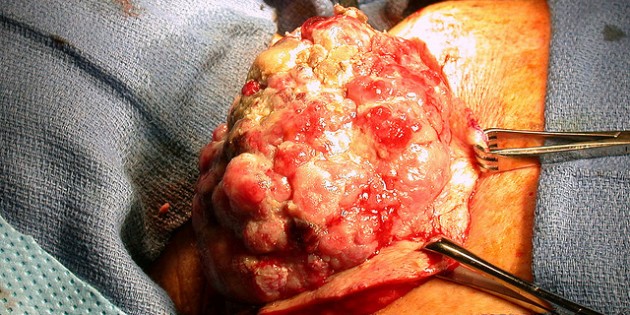
Unbelievably, the method of producing vaccines using cells that are derived directly from human cancer tumors has been approved even though the vaccines may induce cancer in recipients. This method is cheaper and faster than breeding animals for the culture media – and human cancer tumors are readily available.
At a meeting of the Food and Drug Administration (FDA) in September 2012, the discussion which led to approval was no less than a scandal. [1]
The health authorities and vaccine manufacturers blatantly revealed their uncertainty regarding the safety of vaccines made from cancer tumors. Some of the incredible statements from the meeting are quoted directly. A more detailed account is given in this article. [2]
The statements in italics are directly quoted from the meeting.
The vaccines may cause tumors in recipients
“We have really identified three major factors that could potentially convey risk from tumor derived cells. And these include the cells themselves … and if they were tumor-derived cells then maybe they themselves could form tumors in a vaccine recipient.” (Dr. K)
A fact: tumor cell lines can cause tumors
“What I think is qualitatively different about the tumor cell lines is the fact that they can cause tumors.” (Dr.L)
Tumors may occur decades after vaccinations
“But certainly, if you are going to address this question about tumor risk of vaccines made in tumor cell lines, it’s going to have to be a decade’s question.” (Dr.C)
FDA is there to help vaccine manufacturers
“… but we are here to consider the issues that we would like to advise the agency to consider in helping the company continue the manufacturing process, what should they be concerned about, what should they be watching for.” (Dr. D, leader of the meeting)
Doubt regarding test animals for assessing oncogenicity
“I’m not optimistic that we’re going to find animal models to assess oncogenicity of DNA. That’s why I’m feeling that maybe it’s the clearance aspect that we have to deal with, with respect to DNA.” (Dr.P)
Uncertainty about length of time for safety testing
“Are they watching these animals long enough? Should it be longer?” (Dr.D)
“Is it relevant to safety that a cell forms a tumor after a year, a year and a half?” (Dr.P)
Poor testing for prions including mad cow disease
“There are a lot of things to be done in post-licensure. The field of the BSE (Bovine Spongiform Encephalopathy, mad cow disease) is really, in terms of sensitivity, of detection, pretty poor” (Dr.C)
Doctors and the public may say “Oh, my God”!
“How is this group (of vaccines) going to be able to be accepted by the consumers … As soon as you hear “a tumor-derived cell line”, how do you explain that, put the public at ease?” (Dr.B)
“… the practicing medical community and also the lay public. They are going to hear that we are recommending or that the manufacturers are making vaccines with tumorigenic cell lines and say, oh, my God, even if there’s no scientific basis to say, oh, my God.” (Dr.D)
Framing information to convince doctors and the public
“… because it’s a discussion of how one communicates these issues and how the public will perceive them. But I’m not completely sure that we have a complete answer on the fundamental scientific question. So how can you communicate a scientific concensus that the product is safe unless we’re sure that you, the experts we are asking to advise us are convinced that it’s safe?” (Dr.K)
Plan to hide information and omit it from package inserts
“The minute you describe something in the package insert in terms of potential clinical safety concerns, I think that really precludes using these cell substrates.” (Dr. G)
“When it gets right down to what’s in the vial and what the patient is going to ask me about, whether it’s safe, I’m not going to say, well, you know, HeLa cells kill nude mice.” (Dr. C)
“I don’t know that our charge is to micromanage the package insert today. I think that’s a new discussion, with lots of issues that we haven’t really aired completely.” ( Dr.D)
Authorities uncertain about safety
“So I’m not sure that we can give a certainty – there’s no risk, don’t worry about this. – It’s sort of a brave new world. We’re all doing it together. But I think that you are doing a beautiful job.” (Dr. D)
Will learn about the risks as time goes by
“… even though there are challenges to using the new technologies, they have to be embraced and we have to continue to try to learn from them and struggle through that learning curve.” (Dr.M)
Leader of the committee says “I’m a vaccine guy”, then suggests approval
“I’m a vaccine guy. They are wonderful to prevent infectious diseases … I hope that I’m speaking for everybody when I say that’s the answer to your question. If not, please chime in now.” (Dr.D)
The committee formally approves the method of making vaccines from human cancer tumors
“To come back to the agency’s question of whether this Committee believes it’s correct scientifically to go forward with the development of these vaccines, our answer is yes.” (Dr.D)
Conclusion
Sometimes reality is even more frightening than horrific science fiction
Millions of consumers will be injected with vaccines which may cause cancer tumors, then cancer tumors will be used to make millions of vaccines. Think about it.
vactruth.com/2014/11/30/vaccines-made-from-cancer-tumors/